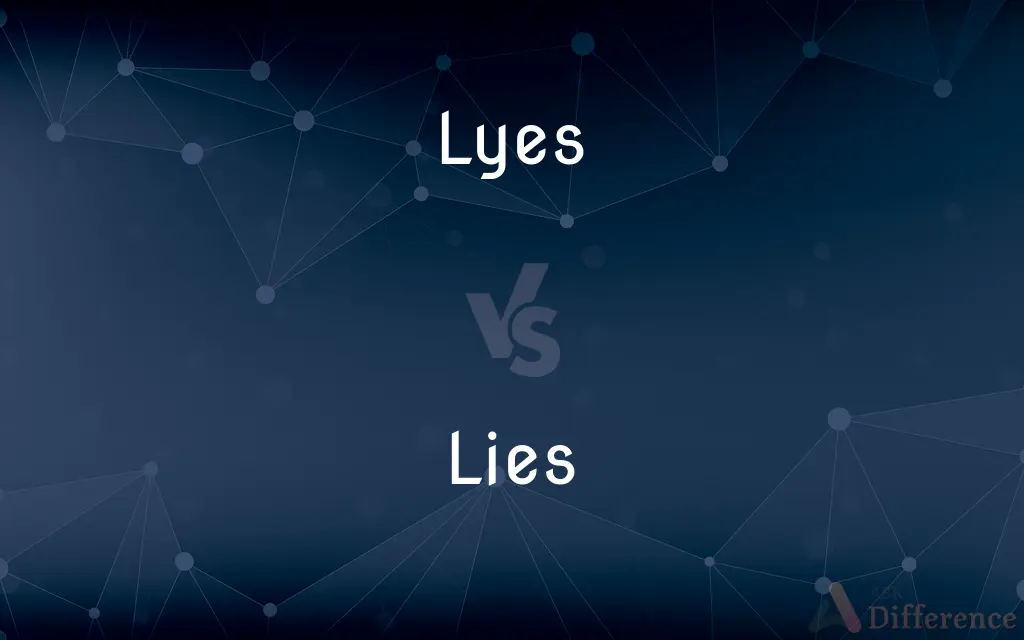Lyes vs. Lies — What's the Difference?
By Tayyaba Rehman & Maham Liaqat — Updated on March 22, 2024
Lyes are strong alkaline solutions used in cleaning and manufacturing, while lies refer to false statements made with the intent to deceive.

Difference Between Lyes and Lies
Table of Contents
ADVERTISEMENT
Key Differences
Lyes, in the context of chemistry and manufacturing, are potent alkaline solutions notable for their caustic properties and utility in processes like soap making, drain cleaning, and food preparation. These substances, typically consisting of sodium hydroxide (NaOH) or potassium hydroxide (KOH), are crucial in industries for their ability to react with fats and oils to produce soap, among other applications. On the other hand, lies are deliberate falsehoods or misrepresentations intended to deceive others. The concept of lying pertains to ethical and psychological domains, reflecting a conscious choice to mislead through false statements or omissions.
The distinction between lyes and lies extends beyond their definitions to their applications and implications. While lyes play a practical role in various industrial and domestic settings, contributing to manufacturing, cleaning, and even food preparation processes, lies impact social interactions and ethical considerations, influencing trust, relationships, and societal norms.
Understanding the nature of lyes involves recognizing their chemical properties and potential hazards, as their caustic nature requires careful handling and specific applications to avoid harm. Conversely, comprehending lies entails an awareness of the motivations and consequences of deceit, encompassing a range of behaviors from white lies to significant fabrications that can affect personal and professional contexts.
Despite their homophonic similarity, lyes and lies occupy distinctly different spaces in language and function. Lyes are discussed within scientific, industrial, and technical contexts, emphasizing safety, utility, and chemical reactions. In contrast, lies are a subject of ethical, psychological, and interpersonal discourse, focusing on honesty, trust, and the ramifications of deceit.
The significance of lyes in practical applications, such as cleaning and soap making, underscores their value in everyday life and industrial processes, highlighting the importance of chemical science in enhancing and facilitating various tasks. Meanwhile, the concept of lies touches upon the fundamental aspects of human interaction and communication, underscoring the complexities of honesty, integrity, and the social fabric.
ADVERTISEMENT
Comparison Chart
Definition
Strong alkaline solutions used in cleaning and manufacturing
False statements made to deceive
Context
Chemistry, manufacturing, cleaning
Ethical, psychological, interpersonal
Applications
Soap making, drain cleaning, food preparation
Influencing perceptions, hiding truth
Implications
Chemical safety, industrial utility
Trust, relationships, societal norms
Nature
Caustic, requires careful handling
Intentional, varies in harm
Compare with Definitions
Lyes
Strong alkaline substances used in soap making.
Lyes react with fats to produce soap.
Lies
Misleading information to hide the truth.
The article was based on lies, leading readers astray.
Lyes
Caustic solutions for cleaning purposes.
He used lyes to unclog the drain effectively.
Lies
False statements with intent to deceive.
She told lies to avoid getting into trouble.
Lyes
Utilized in paper manufacturing.
Lyes play a crucial role in breaking down wood pulp.
Lies
White lies, told to avoid hurting someone's feelings.
He told white lies about liking the meal to not offend the host.
Lyes
Key ingredient in traditional food preparation.
Lutefisk is prepared using lyes to soften the fish.
Lies
Fabrications in storytelling.
The novel was filled with lies, creating a fascinating narrative.
Lyes
Hazardous if not handled properly.
Always wear gloves when working with lyes to avoid burns.
Lies
Breaches of trust in relationships.
Lies can damage relationships beyond repair.
Lyes
Plural of lye
Lies
To be or place oneself at rest in a flat, horizontal, or recumbent position; recline
He lay under a tree to sleep.
Lies
To be placed on or supported by a surface that is usually horizontal
Dirty dishes lay on the table. See Usage Note at lay1.
Lies
To be or remain in a specified condition
The dust has lain undisturbed for years. He lay sick in bed.
Lies
To exist; reside
Our sympathies lie with the plaintiff.
Lies
To consist or have as a basis. Often used with in
The strength of his performance lies in his training.
Lies
To occupy a position or place
The lake lies beyond this hill.
Lies
To extend
Our land lies between these trees and the river.
Lies
To be buried in a specified place.
Lies
(Law) To be admissible or maintainable.
Lies
(Archaic) To stay for a night or short while.
Lies
To present false information with the intention of deceiving.
Lies
To convey a false image or impression
Appearances often lie.
Lies
To say or write as a lie.
Lies
The manner or position in which something is situated.
Lies
A haunt or hiding place of an animal.
Lies
(Sports) The position of a golf ball that has come to a stop.
Lies
A false statement deliberately presented as being true; a falsehood.
Lies
Something meant to deceive or mistakenly accepted as true
Learned his parents had been swindlers and felt his whole childhood had been a lie.
Lies
Plural of lie
Lies
(Mid-Ulster) Great, wonderful
That kebab was lies!
Common Curiosities
Can lyes be safely used in food preparation?
Yes, lyes can be used safely in specific food preparations, such as in making pretzels or lutefisk, when handled according to food safety guidelines.
How are lyes made?
Lyes are typically produced by leaching ashes (for potassium hydroxide) or through chemical processes involving sodium or potassium salts.
Are there any positive aspects to telling lies?
While generally considered unethical, "white lies" can sometimes be told to avoid hurting someone's feelings or to protect someone from harm.
How do lies affect interpersonal relationships?
Lies can erode trust, create misunderstandings, and weaken the foundation of interpersonal relationships.
What safety measures should be taken when using lyes?
Safety measures include wearing protective gear, following handling instructions, and ensuring proper ventilation.
How can exposure to lyes be harmful?
Due to their caustic nature, lyes can cause chemical burns, skin irritation, and other injuries if not handled with proper safety precautions.
Can the regular use of lyes in cleaning be harmful to surfaces or materials?
Yes, the caustic nature of lyes can damage certain materials over time, so it's important to use them as recommended for specific cleaning tasks.
Why might someone find it hard to stop lying?
Habitual lying can be a complex issue, tied to psychological factors, fear of consequences, or a desire to manipulate situations.
What are lyes used for?
Lyes are used in soap making, drain cleaning, and various industrial processes due to their strong alkaline properties.
Why do people tell lies?
People tell lies for various reasons, including to deceive, protect someone's feelings, or conceal the truth.
What are the consequences of telling lies?
Lies can lead to mistrust, damaged relationships, and ethical dilemmas, impacting both the liar and those deceived.
How do cultural perceptions of lying vary?
Cultural perceptions of lying vary widely, with some cultures viewing certain types of lies more leniently, especially when they serve social harmony.
Is it legal to use lyes in consumer products?
Yes, lyes can be legally used in consumer products, such as in soaps and cleaners, as long as they comply with safety regulations.
What distinguishes a lie from a mistake?
A lie involves intentional deceit, while a mistake is an unintentional error or misunderstanding.
How has the use of lyes evolved over time?
The use of lyes has evolved from basic soap-making and food preparation to a wide range of industrial applications, reflecting advancements in chemistry and manufacturing.
Share Your Discovery

Previous Comparison
Collarbone vs. Clavicle
Next Comparison
Inclusive vs. ExclusiveAuthor Spotlight
Written by
Tayyaba RehmanTayyaba Rehman is a distinguished writer, currently serving as a primary contributor to askdifference.com. As a researcher in semantics and etymology, Tayyaba's passion for the complexity of languages and their distinctions has found a perfect home on the platform. Tayyaba delves into the intricacies of language, distinguishing between commonly confused words and phrases, thereby providing clarity for readers worldwide.
Co-written by
Maham Liaqat















































